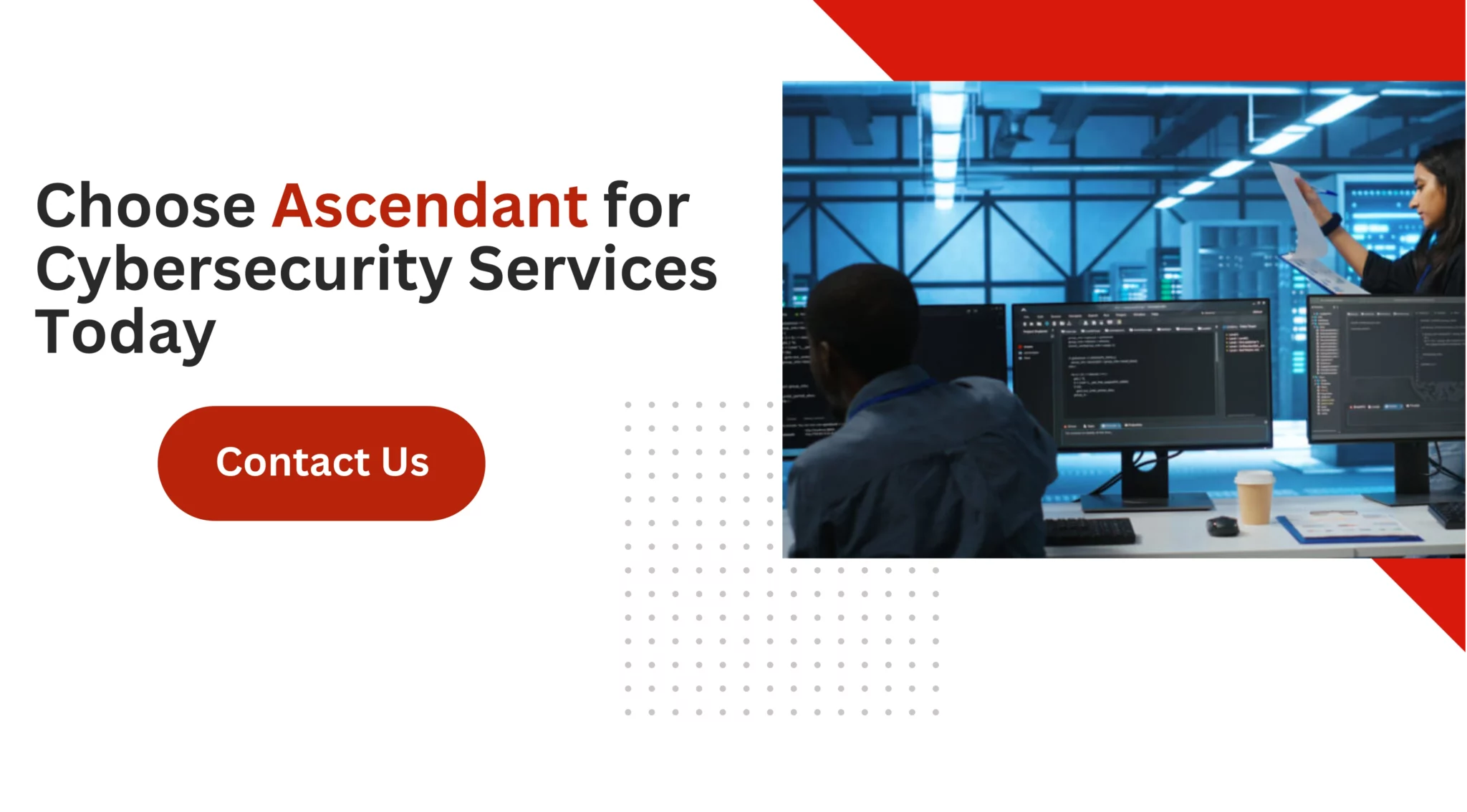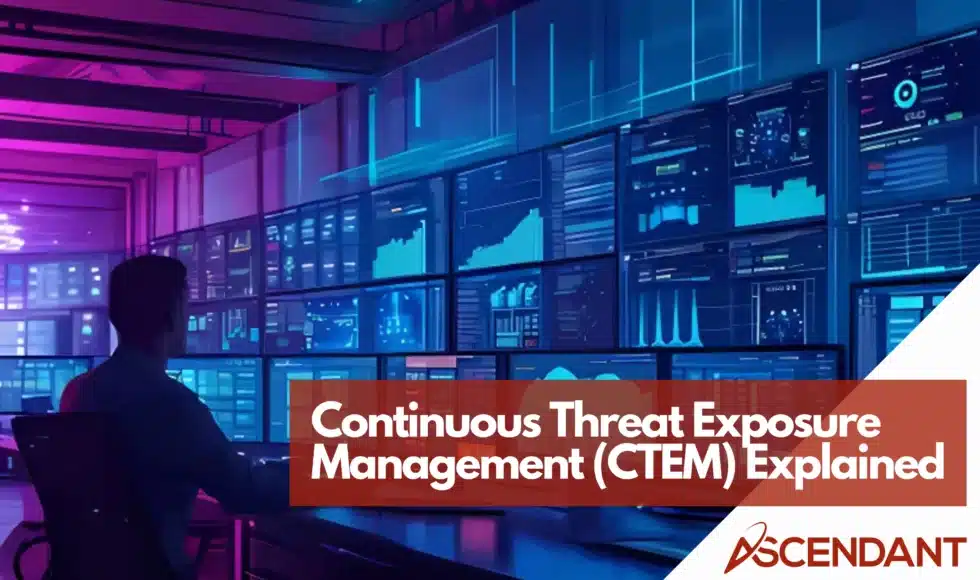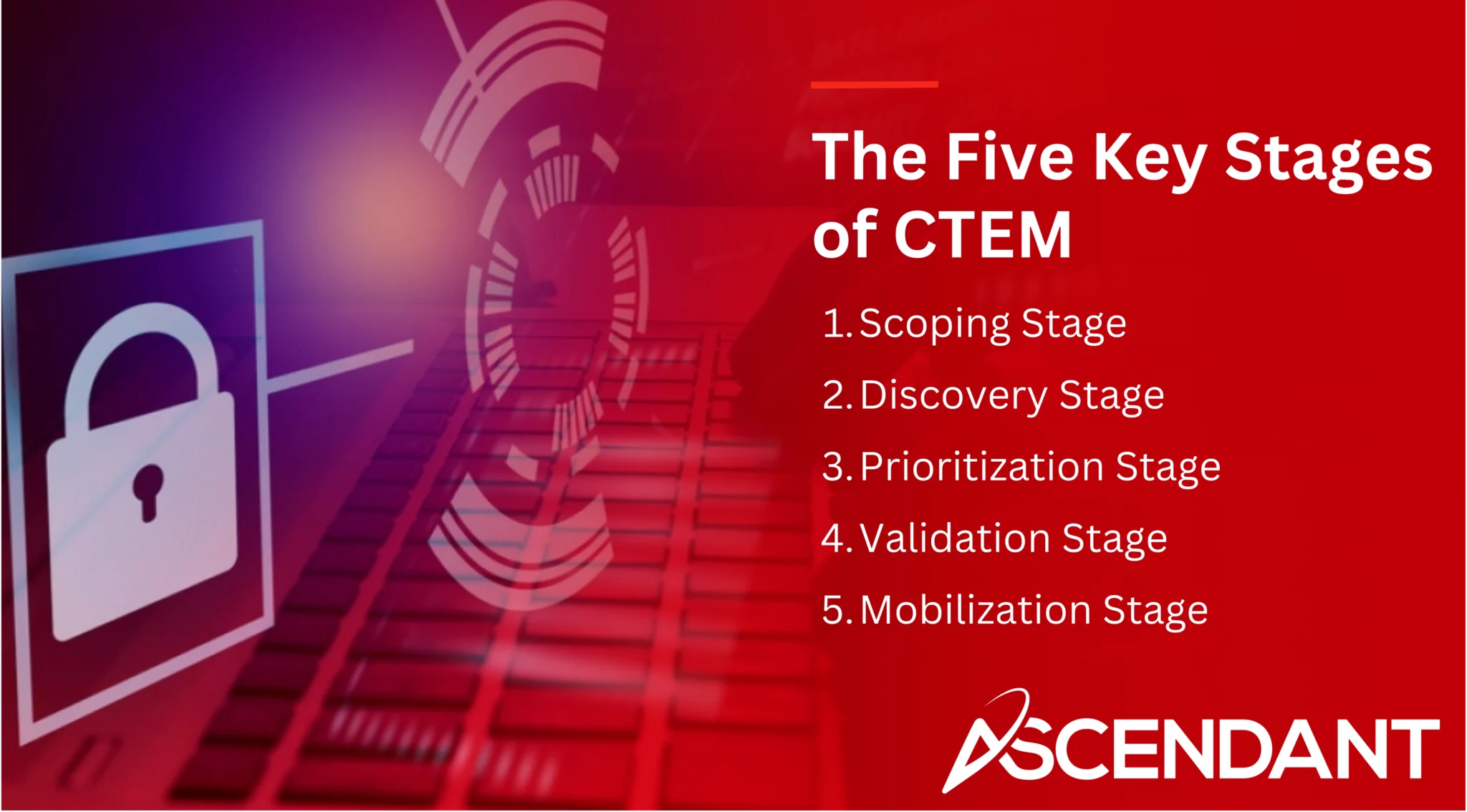Continuous Threat Exposure Management (CTEM) enables organizations to proactively handle cyber threats. In this guide, you’ll learn what CTEM is, why it’s important, and how its five-stage process can enhance your cybersecurity efforts.
Key Takeaways
- CTEM (Continuous Threat Exposure Management) is a proactive cybersecurity framework that emphasizes risk mitigation over traditional assessment methods, encompassing cloud, remote, and on-premises assets.
- The CTEM process consists of five key stages: Scoping, Discovery, Prioritization, Validation, and Mobilization, each critical for identifying and addressing potential vulnerabilities continuously.
- Implementing CTEM enhances security posture by allowing organizations to adapt quickly to emerging threats, improve resource allocation, and achieve significant ROI on security investments.
Understanding CTEM: An Overview
The approach of Continuous Threat Exposure Management (CTEM) is a five-phase strategy emphasizing preemptive actions aimed at reducing the likelihood of cyber attacks. Positioned as an essential strategic technology trend by 2024, CTEM marks a pivotal turn toward proactive management in cybersecurity. Its foremost purpose is to arrange risk mitigation efforts and refine plans that bolster security posture, thereby decreasing the chance for vulnerabilities to be taken advantage of.
In contrast to conventional cybersecurity evaluations, programs based on CTEM extend their reach beyond simple identification by connecting identified weaknesses with possible attack trajectory, prioritizing potential risks accordingly, and overseeing the progress made during remediation stages. This encompassing method takes into account assets across cloud services, remote areas, and local infrastructure to deliver an all-inclusive assessment setting. Foundational activities like red team exercises, penetration testing, vulnerability scans, among other forms of assessments are key constituents enhancing overall security within this framework.
Having a solidly constructed CTEM architecture in place is imperative for it enables effective pinpointing and alleviating potential threats. By tackling vulnerabilities prior to exploitation opportunities being available to adversaries, companies can reinforce their security stance significantly. Such preventive measures guarantee organizations’ readiness against prevailing threats while facilitating continual adaptation to novel or emerging exposures.
The Five Key Stages of CTEM
The CTEM framework is designed as a five-step method for efficiently managing vulnerability exposures. The critical phases of the CTEM process include:
- Scoping
- Discovery
- Prioritization
- Validation
- Mobilization
Every phase is integral in guaranteeing that organizations maintain persistent vigilance and reactivity to cyber threats and potential threats, thus offering a robust and proactive methodology for enhancing the organization’s security posture.
Scoping Stage
During the Scoping Stage, it is essential to establish clear protection objectives and determine which assets are particularly susceptible. This phase lays down precise goals for defense and creates a basis for subsequent actions aimed at thwarting potential threats. By pinpointing critical assets in this stage, companies can concentrate their security efforts on areas of greatest importance, ensuring priority is given to components that carry significant value or face heightened risk.
Ensuring that the measures taken during the Scoping Stage correspond with business aspirations and approaches to managing risk guarantees that implemented security tactics not only safeguard an organization’s exposed attack surface but also contribute meaningfully toward overarching business risk management endeavors.
Discovery Stage
During the Discovery Phase of CTEM, evaluating vulnerabilities, incorrect configurations, and possible avenues for attack is essential. This phase entails pinpointing known vulnerabilities (CVEs), configuration mistakes, risks associated with identity management and excessive permissions within various environments. Revealing such susceptibilities grants organizations crucial understanding concerning their potential areas of exploit and underlying security flaws.
The interlinking nature of these exposures can forge sequences that may be exploited to compromise pivotal assets. Concentrating on weaknesses tied to identities or circumventing exterior defenses characterizes this stage’s intent to offer a detailed appraisal of an organization’s overall security posture.
Prioritization Stage
During the Prioritization Stage, Attack Graph Analysis is utilized to accurately prioritize threats by evaluating their intelligence and complexity of the attack path. This assessment includes examining threat levels alongside asset significance, enabling organizations to ascertain risk magnitudes for better resource distribution toward prominent vulnerabilities. It makes clear which remediation efforts will substantially diminish risks affecting critical assets, thereby directing resources effectively.
CTEM enhances the process of remediating vulnerability management by ranking risks tied to vital assets according to their probable impact. By adopting this proactive stance on risk management, it guarantees that resources are distributed efficiently and focuses on mitigating urgent threats first.
Validation Stage
In the Validation Stage of CTEM, simulated attacks are utilized to verify if potential threats can be exploited. It evaluates the capability of security controls to thwart such identified threats within particular settings. The main objective during this phase is to appraise the manner and probability of possible attacks, granting a true-to-life appraisal of an organization’s defensive posture.
Throughout this crucial stage, multiple instruments are employed in order to imitate assaults and scrutinize vulnerabilities. Inherent in CTEM is continuous monitoring. It plays a pivotal role by incessantly pinpointing newly emerging vulnerabilities and exposures, thereby guaranteeing that implemented security measures sustain their effectiveness over time.
Mobilization Stage
During the Mobilization Stage, which is the concluding phase of the CTEM process, it’s essential for security teams to comprehend their responsibilities and recognize the importance of diminishing risks by focusing on deploying robust security controls that can adjust to changing cyber threats.
This stage plays a crucial role in unifying insights from earlier phases and guarantees perpetual adjustment against potential dangers. By engaging in this persistent course of action, an organization ensures its proactive stance towards cybersecurity thereby safeguarding its digital assets effectively.
Benefits of Implementing CTEM
CTEM’s ongoing process empowers organizations to swiftly adjust and tackle emerging threats, thereby bolstering their security posture. This proactive stance facilitated by CTEM lessens the likelihood of breaches by addressing vulnerabilities ahead of time. Such preventive measures not only enhance protection but also have been shown to yield considerable returns on security investments—some entities report as high as 400%.
Through prioritizing defensive actions in line with the severity of potential risks, CTEM elevates organizational compliance and resource allocation efficiency. By zeroing in on the most critical threats, it ensures that strategies employed are both purposeful and impactful against cyber threats, fortifying an organization’s defenses substantially.
Key Components of a Successful CTEM Program
Vulnerability scanners, crucial during the Discovery Stage, play a vital role in uncovering potential security weaknesses. The adoption of continuous monitoring solutions within CTEM frameworks facilitates instantaneous evaluation and control over security risks, enabling entities to proactively confront potential threats.
Incorporating cutting-edge tech such as machine learning and AI into CTEM aids in more accurately detecting and ranking imminent cyber threats. Utilizing sophisticated methods for security testing including red team operations and breach simulations enriches exposure management strategies against credible dangers ensuring fortified protection measures are firmly in place.
How CTEM Enhances Traditional Security Practices
CTEM stands out from traditional penetration testing by conducting continuous analysis, setting priorities for remediation efforts, and monitoring improvements over time. While classic penetration tests provide a snapshot assessment with no follow-up prioritization, they quickly become obsolete, thereby failing to keep up with the need for ongoing threat management. CTEM evaluates the entire environment in an ongoing fashion that adjusts to emerging threats.
Breach and Attack Simulation (BAS) tools are valuable but may hinder system performance on live environments due to operational risks involved. Conversely, CTEM endorses a proactive approach towards cybersecurity that equips organizations to predict and effectively tackle changing cyber threats.
CTEM represents an unceasing endeavor focused on proactively detecting and addressing cyber threats, which bolsters conventional security measures. By tackling various dangers such as configuration errors and issues surrounding identity management, effective CTEM implementations offer all-encompassing defense against cyber risks.
Selecting the Right CTEM Vendor
When choosing a CTEM provider, it is crucial to opt for one that boasts an impressive track record and established expertise in the field of cybersecurity. It’s vital for companies aiming to successfully deploy CTEM and tackle its complexities to engage with specialized service providers. To meet your organization’s expanding security demands, a scalable CTEM solution is indispensable.
Ensuring that the chosen CTEM solution can integrate seamlessly with pre-existing security tools is paramount for gaining a thorough perspective on your organization’s security posture. Dependable customer support plays a pivotal role in troubleshooting problems and providing necessary guidance related to the use of the CTEM system.
The platform selected should be capable of delivering actionable insights which facilitate efficient prioritization and mitigation of threats through clear, easily comprehensible threat intelligence reports.
Real-World Applications of CTEM
In 2020, organizations faced a vast scale of cyber threats, as evidenced by the reporting of 17,000 new vulnerabilities. The proactive management and mitigation of these substantial vulnerabilities have been made possible through the implementation of CTEM programs, demonstrating their real-world efficacy in tackling cyber threats.
Future Trends in CTEM
A Gartner survey has revealed that CTEM programs have been integrated into 75% of organizations, showcasing the increasing appreciation for its role in mitigating cyber risks. There is a significant interest among businesses in this domain, with 60% either actively engaging in a CTEM program or contemplating its implementation.
With an eye toward the future, it’s evident that shifts in trends and advancements in technology will influence the direction of CTEM. As cybersecurity strategies become more sophisticated, CTEM is set to progress accordingly to counteract novel and changing threats effectively. This evolution aims at safeguarding organizations from severe vulnerabilities continuously.
Summary
Implementing Continuous Threat Exposure Management (CTEM) represents a thorough and anticipatory strategy for managing cybersecurity risks. This approach enables organizations to consistently recognize, rank, and address potential threats in an ongoing manner. By adopting CTEM, companies can strengthen their overall security posture, meet compliance requirements more effectively, and achieve substantial returns on investment from their security expenditures. The adoption of exposure management through the lens of CTEM is crucial for maintaining a competitive edge against newly emerging threats while securing enduring resilience in cyberspace.
 Frequently Asked Questions
Frequently Asked Questions
What is the primary goal of CTEM?
The primary goal of CTEM is to reduce the likelihood of exploitation of weaknesses by emphasizing risk mitigation strategies and enhancing security posture improvement plans.
What are the five key stages of CTEM?
The five key stages of CTEM are Scoping, Discovery, Prioritization, Validation, and Mobilization.
Understanding these stages is essential for effective implementation and management of CTEM initiatives.
How does CTEM differ from traditional penetration testing?
CTEM differs from traditional penetration testing by providing continuous analysis and prioritizing remediation, rather than just a one-time assessment. This approach allows for tracking improvements over time, ensuring a more dynamic and effective security posture.
What are some benefits of implementing CTEM?
By adopting CTEM, organizations can better prioritize their security efforts, bolster compliance measures and substantially diminish the chances of experiencing security breaches through proactive vulnerability management.
What should organizations look for in a CTEM vendor?
Organizations should prioritize vendors with a strong reputation, scalability, robust integration capabilities, continuous monitoring services, and dependable customer support to ensure effective CTEM solutions.


